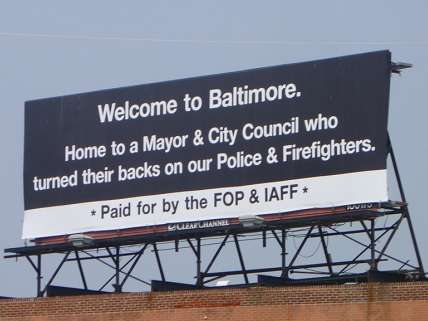New Baltimore Use of Force Policy Doesn't Really Work Without 'Reasonable' Officers
Detailed policy leaves much to the discretion of "reasonable" officers.


The Baltimore Police Department unveiled a new use of force policy, crafted, the department said, with the help of the American Civil Liberties Union of Maryland, the NAACP of Baltimore, and local attorneys, both prosecutors and public defenders.
The new document represents the first major revision of the use of force policy since 2003. Among the more important changes, all types of the use of force (including flashing a weapon at a suspect) now requires notifying a supervisor. The policy also stresses de-escalation, a "duty to intercede" by officers who see other cops use excessive force, and a duty to provide medical assistance when necessary or when requested by the suspect.
"Recognizing that mental illness, post-traumatic stress disorder, alcohol and/or drug addictions, or other health issues can cause individuals to behave erratically," the policy reads, "members must try to de-escalate situations and minimize or avoid using force altogether, when possible, to prevent injuries to the subject, the public and the member."
The document is available via the Baltimore Sun but does not yet appear to be on the Baltimore Police Department's website. The BPD has not had an update on its news site since November 2015.
The policy outlines four types of aggression targets of police action could exhibit—passive resistance, active resistance, active aggression, and aggravated aggression. Lunging toward a police officer counts as "active aggression."
As usual, "reasonableness of a particular use of force is based on the totality of the circumstances known by the officer at the time of the use of force," according to the policy, which refers to the reasonable judgment of police officers (or "members" in the document's vernacular) so often as to render itself worthless. "Reasonable must be judged from the perspective of a reasonable officer on the scene," the use of force policy document declares, insisting the "reasonableness standard is an objective one… without regard to the member's underlying intent or motivation." Later: "Reasonableness is not capable of precise definition or mechanical application" and "must allow for the fact that members are often forced to make split-second decisions-in circumstances that are tense, uncertain, dynamic and rapidly evolving."
Were Baltimore police officers all reasonable people, a simpler use of force policy would suffice. But Baltimore's hiring policies, informed by the police union and cop-friendly big city politicians and hardly unique, don't guarantee reasonable officers. Coupled with privileges extended to cops outside of the deference of the use of force policy—things like the 10-day waiting period to talk about a deadly use of force incident—this contributes to much of the problem of excessive police violence. Baltimore's new use of force policy describes three levels of force. All require notifying a supervisor, but documentation is required only in the two lower levels, a function of the privileges within the Law Enforcement Officers' Bill of Rights that police reformers in Maryland have been unable to reform or repeal.
The use of force policy permits the use of deadly force when "immediately necessary to protect a member or another person from imminent danger of death or serious physical injury." Deadly force can also be used on fleeing suspects, provided that the officer believes "it is necessary," that the suspect has committed or is committing a felony involving physical injury or death, that the suspect's escape would threaten the cop or another person, and that, when possible, the officer "has given verbal warning to the suspect."
"When practical, a member should identify himself/herself as a law enforcement officer and state his/her intention to use deadly force before using a friearm or employing deadly force," the policy reads.
The policy prohibits deadly force to "subdue persons whose actions are a threat only to property" or "against persons whose conduct is a threat only to themselves." Choke holds are prohibited "unless deadly force is authorized." The policy prohibits warning shots and cops from shooting from or at moving vehicles except "to counter an imminent threat" or when a cop is "unavoidably in the path of the vehicle and cannot move safely."
The new policy also deals with "dangerous animals," permitting the use of deadly force against animals when "alternative options are not available or would likely be ineffective," directing cops to look for dangerous animals in pre-raid surveillance as well as to develop "reasonably contingency plans" for dealing with dangerous animals.
Show Comments (37)